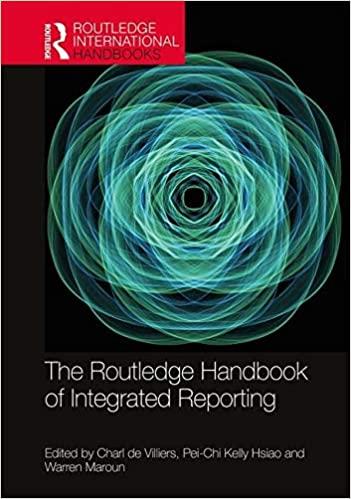


Exhibit : Excerpts from Breez's Notes from His Cost of Capital Research 1. The cost of capital is really the required rate of return or hurdle rate that a firm should use to evaluate capital budgeting projects of average risk. 2. The cost of capital is a weighted average of the required return for each financing source. The weights should be based on market values and should be representative of the firm's optimal capital mix. 3. All debt should not be included. Spontaneous sources like accruals and accounts payable should not be counted. Notes payable should only be included if the firm is using bank loans as a permanent source of long-term financing. Exhibit II: Historical Estimates of Yearly Returns on Certain Investments: 1926 - 2004 Investment Arithmetic Return Geometrie Return Standard Deviation Common Stocks 12.39% 10.43% Long-term Government Bonds 5.82% 5.44% 9.30 T-Bills 3.76% 3.72% 3.14 20.32 4.32 Inflation 3.12% 3.04% Historic Equity Premium (Gov. Bonds) 6.57% 4.99% Historic Equity Premium (Gov. Bills) 8.63% 6.71% Source: Ibbotson Associates, Stocks, Bonds, Bills, and Inflation, Valuation Edition, 2006 Yearbook. (%) Year 2007 2008 2009 2010 2011 2012 2013 Projected Exhibit III: SCRPC's EPS and DPS Information EPS Change (%) $1.22 $1.84 3.98 $2.85 54.89 $3.25 14.04 $3.12 -4.00 $3.15 0.96 $3.35 6.35 DPS $0.92 $0.96 $1.01 $1.06 $1.10 $1.16 $1. 225 4.34 5.50 4.95 3.77 5.45 .17 Exhibit IV: SCRPC's Balance Sheet Information ($000s) Accounts Payable Accruals and Other Current Liabilities Notes Payable (for working capital) TOTAL CURRENT LIABILITIES BOOK $120,124 64,111 58,125 242,360 Long-term Debt TOTAL LIABILITIES 275,000 517,360 Preferred Stock (par $100) Common Equity ($1 par) Excess of Par Retained Earnings TOTAL LIABILITIES AND EQUITY 5,000 10,000 40,000 458,445 $1,030,805 Exhibit V: Market, Industry, and SCRPC's Financial Information Treasury Bill Rate 4.25% Long-term Government Bond Yield 7.45% Long-term Corporate Bond Yield 8.75% Average Beta for Industry 1.25 SCRPC'S Beta 1.45 Average P/E Ratio for Industry 13.50 SCRPC'S Recent P/E Ratio 10.75 Recent Price of SCRPC's Common Stock $36.01 SCRPC's Tax Rate 40% SCRPC's Bond Risk Premium 4.0% SCRPC's Bond's are selling at $910 with a Coupon. Rate of 7.25 and maturity of 14 years. Floatation costs for the bonds would be $5 per bond. SCRPC's preferred stock ($100 par) pays a $14 dividend and is selling for $110. The firm would have a $5 floatation cost if it sold preferred stock today. If SCRPC sold additional common stock, the floatation cost and the decline in value would be about 20% of the current price. What is SCRPC's cost of capital when the firm has to issue new common stock and the Gordon Model estimate is used? (See Exhibit VII). Exhibit VII: Find the WACC (using new common stocks) After tax Cost Market Value (000's) Weight Contribution Component Notes Payable Bonds Preferred Stock Common Stock TOTAL Exhibit : Excerpts from Breez's Notes from His Cost of Capital Research 1. The cost of capital is really the required rate of return or hurdle rate that a firm should use to evaluate capital budgeting projects of average risk. 2. The cost of capital is a weighted average of the required return for each financing source. The weights should be based on market values and should be representative of the firm's optimal capital mix. 3. All debt should not be included. Spontaneous sources like accruals and accounts payable should not be counted. Notes payable should only be included if the firm is using bank loans as a permanent source of long-term financing. Exhibit II: Historical Estimates of Yearly Returns on Certain Investments: 1926 - 2004 Investment Arithmetic Return Geometrie Return Standard Deviation Common Stocks 12.39% 10.43% Long-term Government Bonds 5.82% 5.44% 9.30 T-Bills 3.76% 3.72% 3.14 20.32 4.32 Inflation 3.12% 3.04% Historic Equity Premium (Gov. Bonds) 6.57% 4.99% Historic Equity Premium (Gov. Bills) 8.63% 6.71% Source: Ibbotson Associates, Stocks, Bonds, Bills, and Inflation, Valuation Edition, 2006 Yearbook. (%) Year 2007 2008 2009 2010 2011 2012 2013 Projected Exhibit III: SCRPC's EPS and DPS Information EPS Change (%) $1.22 $1.84 3.98 $2.85 54.89 $3.25 14.04 $3.12 -4.00 $3.15 0.96 $3.35 6.35 DPS $0.92 $0.96 $1.01 $1.06 $1.10 $1.16 $1. 225 4.34 5.50 4.95 3.77 5.45 .17 Exhibit IV: SCRPC's Balance Sheet Information ($000s) Accounts Payable Accruals and Other Current Liabilities Notes Payable (for working capital) TOTAL CURRENT LIABILITIES BOOK $120,124 64,111 58,125 242,360 Long-term Debt TOTAL LIABILITIES 275,000 517,360 Preferred Stock (par $100) Common Equity ($1 par) Excess of Par Retained Earnings TOTAL LIABILITIES AND EQUITY 5,000 10,000 40,000 458,445 $1,030,805 Exhibit V: Market, Industry, and SCRPC's Financial Information Treasury Bill Rate 4.25% Long-term Government Bond Yield 7.45% Long-term Corporate Bond Yield 8.75% Average Beta for Industry 1.25 SCRPC'S Beta 1.45 Average P/E Ratio for Industry 13.50 SCRPC'S Recent P/E Ratio 10.75 Recent Price of SCRPC's Common Stock $36.01 SCRPC's Tax Rate 40% SCRPC's Bond Risk Premium 4.0% SCRPC's Bond's are selling at $910 with a Coupon. Rate of 7.25 and maturity of 14 years. Floatation costs for the bonds would be $5 per bond. SCRPC's preferred stock ($100 par) pays a $14 dividend and is selling for $110. The firm would have a $5 floatation cost if it sold preferred stock today. If SCRPC sold additional common stock, the floatation cost and the decline in value would be about 20% of the current price. What is SCRPC's cost of capital when the firm has to issue new common stock and the Gordon Model estimate is used? (See Exhibit VII). Exhibit VII: Find the WACC (using new common stocks) After tax Cost Market Value (000's) Weight Contribution Component Notes Payable Bonds Preferred Stock Common Stock TOTAL









